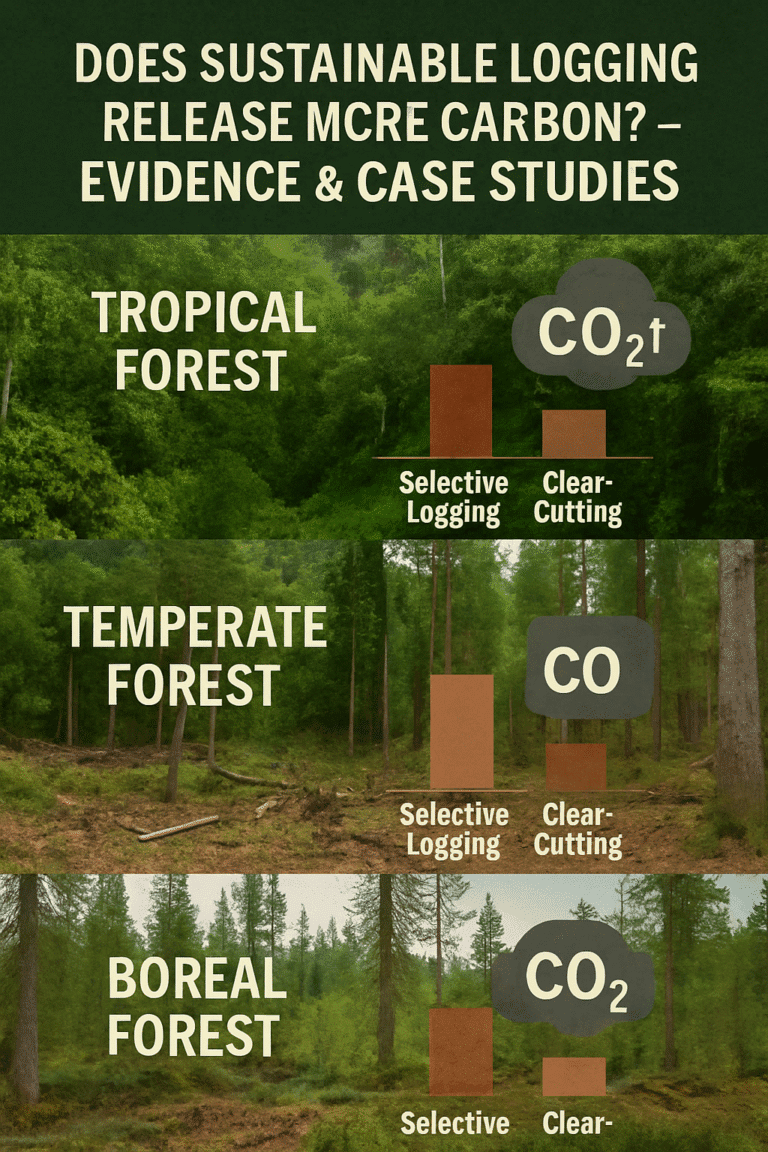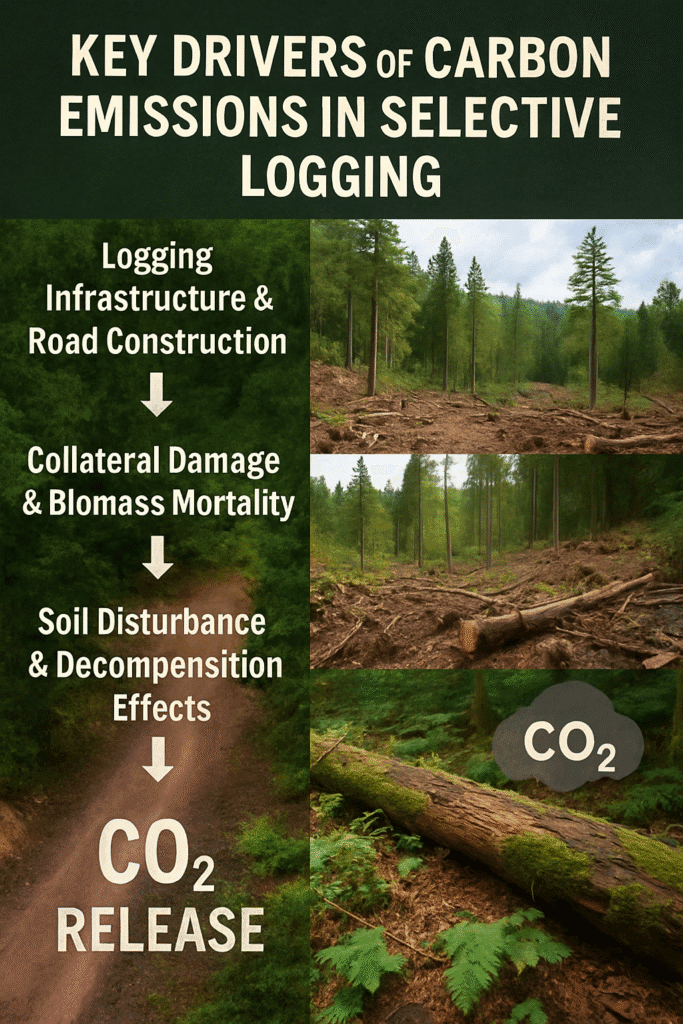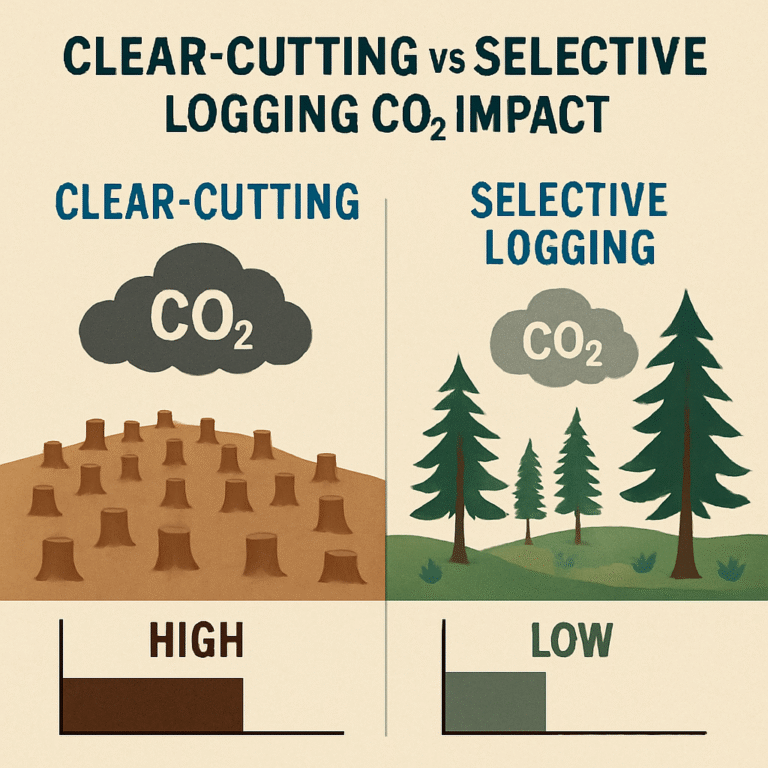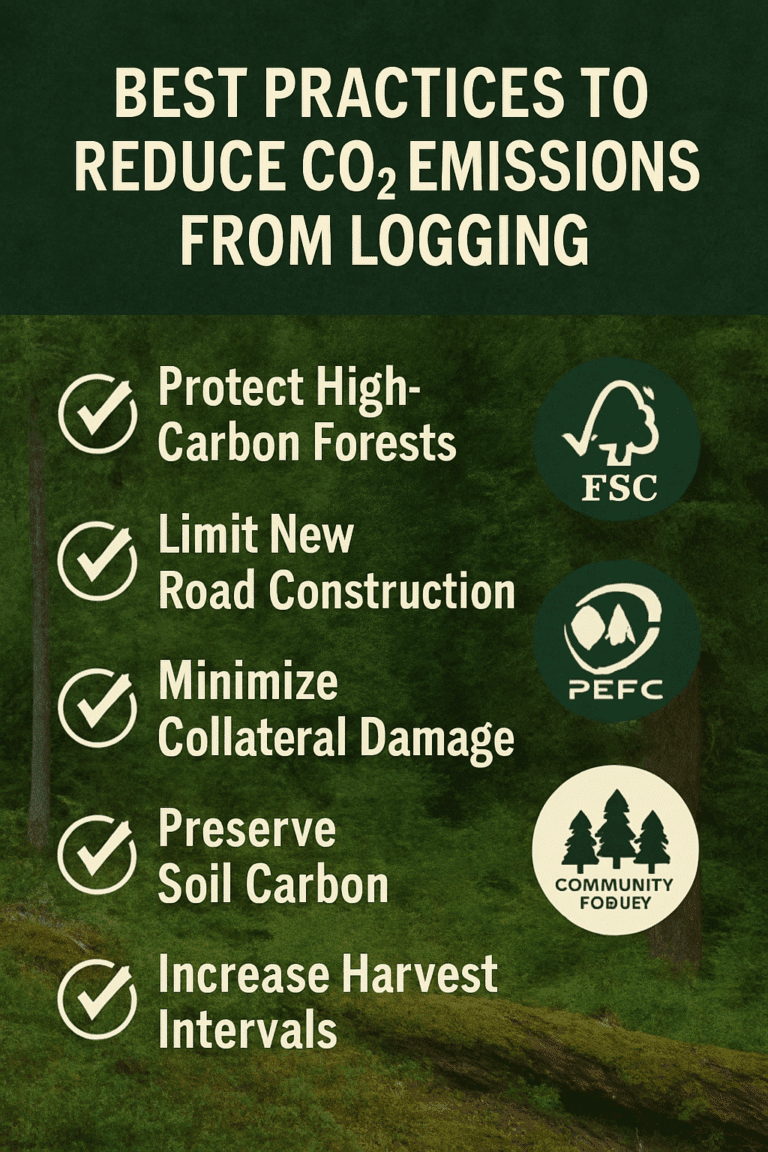
Table of Contents
ToggleWhat is carbon emissions by selective logging
Many authorities and countries present sustainable logging as an eco-friendly alternative to traditional clear-cutting. This idea is very simple – Instead of removing all trees in an area, loggers selectively harvest only certain trees and leave the rest of the forest intact. In theory, this method maintains forest structure, supports biodiversity, and allows continuous carbon storage.
However, growing research is challenging this green reputation and revealing that carbon emissions by selective logging or sustainable logging can still be substantial. When a tree is filled, then its stored carbon begins to release into the atmosphere when the wood decays or is processed. Selective logging involves access to roads, usage of heavy machinery, and disturbing the soil, all of which emit carbon. Canopy gaps expose the forest floor to more sunlight, which can dry the soil and accelerate decomposition, which further boosts carbon emissions from selective logging.
So, in short, while sustainable logging may reduce immediate destruction compared to clear-cutting, it is still far from carbon neutral. Understanding its true emissions is critical for saving realistic forest management policies and also for questioning whether the sustainable label always reflects environmental reality. Hidden sustainable logging problems.

Key drivers of sustainable logging Carbon emissions
Selective logging may look sustainable on paper, but its real-world carbon footprint can be surprisingly high. The problem isn’t just the trees that are removed, it’ss the chain reaction of ecological and physical changes that are triggered in the forest. Green parking lots – emerging global trend.
1. Collateral Damage to Uncut Trees
When one tree is filled, it may rarely fall without affecting its neighbours. Branches often smash into surrounding trees and root systems are distributed. Many of these injured trees die slowly over the next few years why quietly releasing stored carbon in the process.
2. Soil Carbon Loss from Disturbance
Forest soils are massive carbon vaults. Heavy logging equipment compacts the ground and disrupts soil structure + exposing buried organic matter to the air. Once oxygen hits it, the microbial activity speeds up, which breaks down organic matter and releases carbon dioxide. This hidden source of emissions often goes unreported in logging impact assessments.
3. Microclimate Shifts That Accelerate Decay
When the large canopy trees are removed, then more sunlight and wind reach the forest floor. It results in warmer and drier conditions, which increase decomposition rates in leaf litter and woody debris, further increasing carbon loss.
4. Slow Carbon Payback Time
Older trees hold vastly more carbon than young saplings. Removing even a few of them can erase decades or centuries of stored and regrowth often can’t match that storage capacity within the same timeframe.
5. Logging Waste and Residual Biomass
Branches , stumps, and rejected logs left behind start to decompose immediately. In tropical regions, this process can be rapid, which releases carbon faster within a few years. In colder regions the Decay is slower but still inevitable.
6. Emission Spillover from Infrastructure & Transport
The logging footprint extends beyond the forest. Roads, bridges, and machinery maintenance create indirect emissions, and transporting and processing Timber consume significant fossil fuels, which are rarely counted in these sustainable labels.
Selective logging can still be a carbon-intensive activity if these factors aren’t managed. True sustainability requires not only selective cutting but also careful protection of soils, microclimates and the surrounding ecosystem.

Clear Cutting vs selective logging carbon impact
| Factor | Clear-Cutting | Sustainable Logging |
|---|---|---|
| CO₂ Emissions (Short-Term) | Very high — removing an entire stand releases a large pulse of carbon immediately. | Lower per event, but repeated entries can add up over time. |
| Soil Health | Removing roots increases erosion and reduces soil quality. | Leaving trees and undergrowth helps preserve soil structure and fertility. |
| Biodiversity | Immediate loss of habitat for many species. | Less immediate destruction, but sensitive species may still decline. |
| Economic Value | High short-term yield but often degrades long-term productivity. | Lower short-term yield but provides steady income over time. |
| Fire Risk | Debris and exposed ground can increase fire risk in some contexts. | Generally lower risk, though poor practices can still raise vulnerability. |
| Best Practices | Allow long recovery periods and protect high-carbon areas. | Use reduced-impact methods, limit road density, and involve local communities. |
Clear-cutting is the most visually dramatic form of logging, which involves the removal of every tree in a defined area. Its carbon impact is immediate and massive because nearly all the stored carbon in the fallen trees is released through decay, burning, or processing. This phenomenon is supported by exposed soil that releases carbon rapidly. Within the first few years, logging carbon by clear-cutting can be the highest among any forest management activity.
Selective logging removes only certain trees and often leaves younger or less valuable species standing. In text format, it may sound less damaging. Carbon emissions from selective logging are not negligible. The removal of high-carbon & mature trees reduces the forest’s storage capacity. Collateral damage in selectively logged areas can affect up to 40% of the remaining trees, which triggers additional CO2 release over time.
The difference lies largely in the time scales. If clear-cut areas are allowed to regenerate, then they can sequester carbon at a rapid rate in the first few decades, though they may take a century to be fully recovered. Selectively logged forests maintain some sequestration capacity but they experience repeated harvests that prevent full carbon recovery. This creates a long-term carbon debt that can approach or even exceed the clear-cutting carbon footprint.
Ultimately both methods release significant carbon and the lower impact label for selective logging must be critically examined through real emission data rather than perception.

Solutions for carbon emissions by selective logging
Strengthening Forest Policy Frameworks
Governments need to set strict carbon emission limits for logging operations rather than just volume-based Timber quotas. If the government mandates carbon accounting for logging companies, then we can ensure that every extraction project measures and reports its total emissions, including transport, road construction, and post-logging decay.
Integrating forest carbon into climate laws can create legal obligation to minimise emissions during harvesting. Brazil’s forest code ties logging permissions to maintain a minimum percentage of native vegetation on private lands.
Third-Party Certification for True Sustainability
Many logging operations misuse the term “sustainable” and hence forest Certification systems are crucial to reduce carbon emissions by selective logging. FSC (Forest Stewardship Council) and PEFC (Programme for the Endorsement of Forest Certification) can help to verify that would comes from responsibly managed forests.
To counter this issue and related – Updated certification criteria should include :
- Verified carbon footprint per cubic meter of wood harvested.
- Proof of minimal damage to non-target trees and soil.
- Transparent replanting and forest regeneration plans.
Reduced-Impact Logging (RIL) Techniques
Pre-harvest inventory mapping : identify and tag trees for selective removal and also avoid unnecessary cuttings.
Directional felling : cut trees in a way that minimizes collateral damage to surrounding vegetation.
Winching & cable systems : Transport logs without creating large skid trails that disturb soil and release stored carbon.
RIL can reduce carbon emissions by selective logging up to 30-50% compared to conventional selective logging. The U.S. Forest Service has documented RIL pilot programs that significantly reduce soil disturbance and post-harvest decay emissions.
According to the US Forest Service report, reduced impact logging (RIL) alone in tropical production forests can cut carbon emissions by 29-50% compared to conventional methods.
Community-led forest monitoring
Indigenous and local communities can act as forest guardians. Authorities can use drones, GPS mapping and ground surveys to monitor compliance. Government and NGOs can fund community-led patrols to equip them with modern technology and provide them with tech training. Community-managed forests have lower carbon emissions by selective logging than industrial managed concessions.
Incentivizing Carbon-Smart Logging
The government should provide tax credits or carbon offset payments to companies that meet low-emissions logging standards. This will encourage the reduction of carbon emissions by selective logging. Another way is to link timber export approvals to verified carbon efficiency. Society should encourage domestic carbon markets where sustainable logging credits can be traded.
FAQs
How does carbon emissions by selective logging impact as compared to conventional logging?
When Sustainable logging done with reduced impact practices it can lower carbon emissions by minimizing damage in surrounding trees, soils and forest carbon stocks. In contrast, the conventional logging often causes greater canopy loss, soil disturbance, and long-term carbon release.
Can selective logging still release significant CO₂ emissions?
Yes. Even with the selective logging, carbon emissions occur due to tree removal, machinery use, and collateral damage to non-target trees. The scale of emissions depends on logging intensity, forest type and how well those reducing-impact techniques are implemented.
What strategies can reduce carbon emissions by selective logging?
Strategies include applying reduced impact logging (RIL), preserving high carbon value trees, and using low-impact machinery while maintaining buffer zones around sensitive ecosystems. Certification schemes like FSC should also ensure compliance with carbon-friendly practices.
